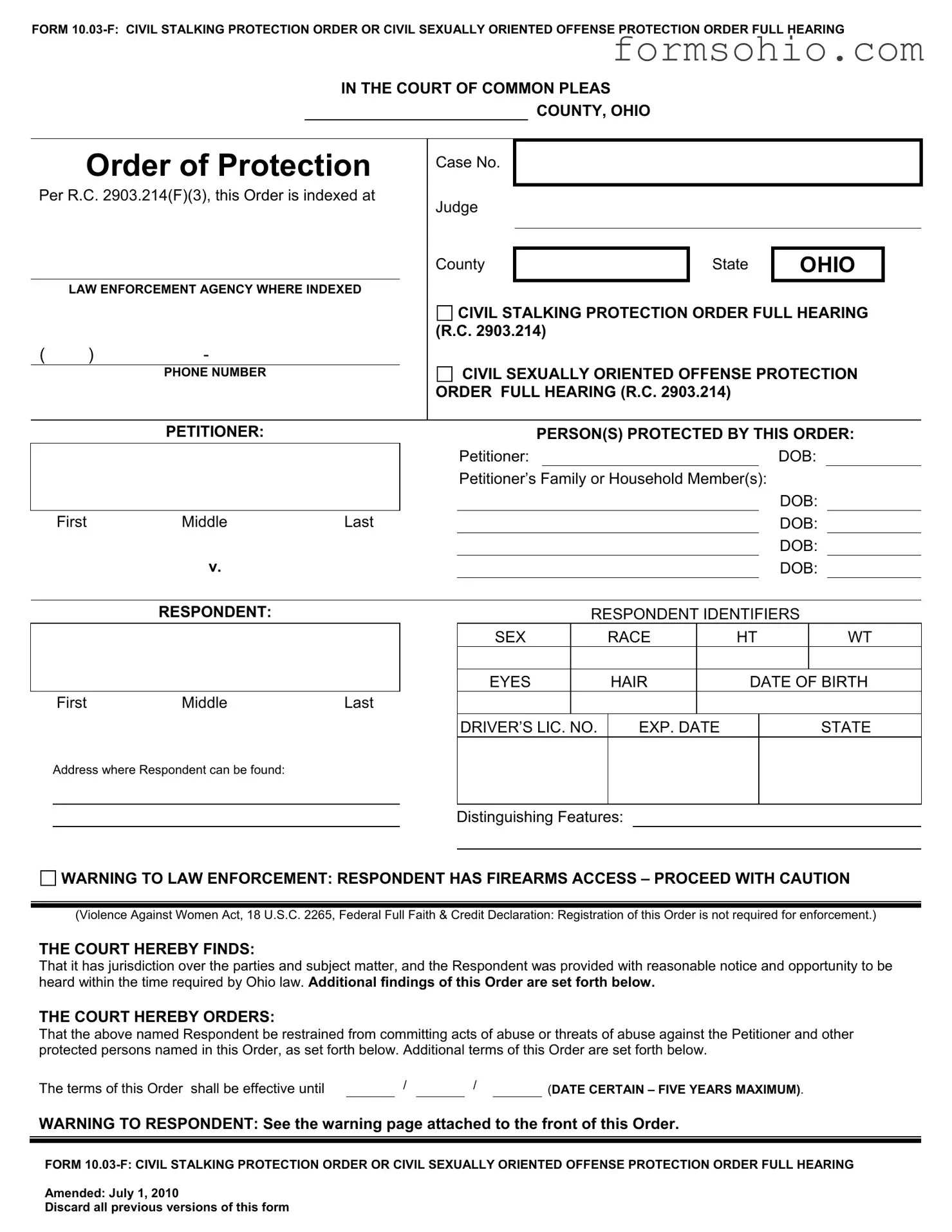FORM 10.03-F: CIVIL STALKING PROTECTION ORDER OR CIVIL SEXUALLY ORIENTED OFFENSE PROTECTION ORDER FULL HEARING
IN THE COURT OF COMMON PLEAS
COUNTY, OHIO
Order of Protection
Per R.C. 2903.214(F)(3), this Order is indexed at
LAW ENFORCEMENT AGENCY WHERE INDEXED
Case No.
Judge

 CIVIL STALKING PROTECTION ORDER FULL HEARING (R.C. 2903.214)
CIVIL STALKING PROTECTION ORDER FULL HEARING (R.C. 2903.214)

 CIVIL SEXUALLY ORIENTED OFFENSE PROTECTION ORDER FULL HEARING (R.C. 2903.214)
CIVIL SEXUALLY ORIENTED OFFENSE PROTECTION ORDER FULL HEARING (R.C. 2903.214)
|
|
|
|
|
|
|
|
|
|
|
PETITIONER: |
|
|
|
PERSON(S) PROTECTED BY THIS ORDER: |
|
|
|
|
Petitioner: |
|
|
DOB: |
|
|
|
|
|
Petitioner’s Family or Household Member(s): |
|
|
|
|
|
|
|
DOB: |
|
First |
Middle |
Last |
|
|
|
DOB: |
|
|
|
|
|
|
|
|
DOB: |
|
|
v. |
|
|
|
|
|
DOB: |
|
RESPONDENT IDENTIFIERS
SEX |
|
RACE |
|
HT |
WT |
|
|
|
|
|
|
EYES |
|
HAIR |
|
DATE OF BIRTH |
|
|
|
|
|
|
DRIVER’S LIC. NO. |
EXP. DATE |
|
STATE |
Address where Respondent can be found:
Distinguishing Features:
WARNING TO LAW ENFORCEMENT: RESPONDENT HAS FIREARMS ACCESS – PROCEED WITH CAUTION
(Violence Against Women Act, 18 U.S.C. 2265, Federal Full Faith & Credit Declaration: Registration of this Order is not required for enforcement.)
THE COURT HEREBY FINDS:
That it has jurisdiction over the parties and subject matter, and the Respondent was provided with reasonable notice and opportunity to be heard within the time required by Ohio law. Additional findings of this Order are set forth below.
THE COURT HEREBY ORDERS:
That the above named Respondent be restrained from committing acts of abuse or threats of abuse against the Petitioner and other protected persons named in this Order, as set forth below. Additional terms of this Order are set forth below.
The terms of this Order shall be effective until |
|
/ |
|
/ |
|
(DATE CERTAIN – FIVE YEARS MAXIMUM). |
WARNING TO RESPONDENT: See the warning page attached to the front of this Order.
FORM 10.03-F: CIVIL STALKING PROTECTION ORDER OR CIVIL SEXUALLY ORIENTED OFFENSE PROTECTION ORDER FULL HEARING
Amended: July 1, 2010
Discard all previous versions of this form
|
[Page 2 of Form 10.03-F] |
|
|
Case No.__________________________ |
This proceeding came on for a hearing on |
|
before the Court and the Civil Stalking |
Protection Order Ex Parte or Civil Sexually Oriented Offense Protection Order Ex Parte filed on all in accordance with R.C. 2903.214. The following individuals were present:
The Court hereby makes the following findings of fact:
The Court finds by a preponderance of the evidence that 1) the Respondent has knowingly engaged in a pattern of conduct that caused Petitioner to believe that the Respondent will cause physical harm or cause or has caused mental distress; and 2) the following orders are equitable, fair, and necessary to protect the persons named in this Order from stalking offenses.
The Court finds by a preponderance of the evidence that 1) the Petitioner or Petitioner’s family or household member(s) are in danger of or have been a victim of a sexually oriented offense as defined in R.C. 2950.01, committed by Respondent; and 2) the following orders are equitable, fair, and necessary to protect the persons named in this Order from sexually oriented offenses.
The Court finds by clear and convincing evidence that 1) the Petitioner or Petitioner’s family or household member reasonably believed the Respondent’s conduct before the filing of the Petition endangered the health, welfare, or safety of the Petitioner or Petitioner’s family or household member(s); 2) the Respondent presents a continuing danger to the Petitioner or Petitioner’s family or household member(s); and 3) the following orders are equitable, fair, and necessary to protect the person(s) named in this Order.
ALL OF THE PROVISIONS CHECKED BELOW APPLY TO THE RESPONDENT
1. RESPONDENT SHALL NOT ABUSE the protected persons named in this Order by harming, attempting to harm, threatening, following, stalking, harassing, forcing sexual relations upon them, or by committing sexually oriented offenses against them. [NCIC 01 and 02]
2. RESPONDENT SHALL NOT ENTER the residence, school, business, place of employment, day care centers, or child care providers of the protected persons named in this Order, including the buildings, grounds, and parking lots at those locations. Respondent may not violate this Order even with the permission of a protected person. [NCIC 03]
3. RESPONDENT SHALL NOT INTERFERE with protected persons' right to occupy the residence including, but not limited to canceling utilities, insurance, interrupting telephone service, mail delivery, or the delivery of any other documents or items.
4. RESPONDENT SHALL SURRENDER all keys and garage door openers to the following residence:
at the earliest possible opportunity after service of this Order to the law enforcement agency that serves Respondent with this Order or as follows:
5. RESPONDENT SHALL STAY AWAY from protected persons named in this Order, and shall not be present
within 500 feet or (distance) of any protected persons, wherever those protected persons may be found, or any place the Respondent knows or should know the protected persons are likely to be, even with protected persons' permission. If Respondent accidentally comes in contact with protected persons in any public or private place, Respondent must depart immediately. This Order includes encounters on public and private roads, highways, and thoroughfares. [NCIC 04]
FORM 10.03-F: CIVIL STALKING PROTECTION ORDER OR CIVIL SEXUALLY ORIENTED OFFENSE PROTECTION ORDER FULL HEARING
Amended: July 1, 2010
Discard all previous versions of this form
[Page 3 of Form 10.03-F]
Case No.__________________________
6. RESPONDENT SHALL NOT REMOVE, DAMAGE, HIDE, OR DISPOSE OF ANY PROPERTY OR PETS owned or possessed by the protected persons named in this Order.
7. RESPONDENT SHALL NOT INITIATE OR HAVE ANY CONTACT with the protected persons named in this Order at their residences, businesses, places of employment, schools, day care centers, or child care providers. Contact includes, but is not limited to, telephone, fax, e-mail, voice mail, delivery service, writings, or communications by any other means in person or through another person. Respondent may not violate this Order even with the permission of a protected person. [NCIC 05]
8. RESPONDENT SHALL NOT CAUSE OR ENCOURAGE ANY OTHER PERSON to do any act prohibited by this Order.
9. RESPONDENT SHALL NOT POSSESS, USE, CARRY, OR OBTAIN ANY DEADLY WEAPON. Respondent shall
turn over all deadly weapons in Respondent’s possession to the law enforcement agency that serves Respondent with this Order or as follows:
Any law enforcement agency is authorized to take possession of deadly weapons pursuant to this paragraph and hold them in protective custody until further Court order. [NCIC 07]
10. IT IS FURTHER ORDERED: [NCIC 08]
11. RESPONDENT IS ORDERED TO COMPLETE the following counseling program:
Respondent shall contact this program within seven days after receiving this Order and immediately arrange for an initial appointment. The counseling program is requested to provide the Court a written notice when Respondent attends the initial appointment, if the Respondent fails to attend or is discharged, and when Respondent completes the program. Respondent is required to sign all necessary waivers to allow the Court to receive information from the counseling program.
|
Respondent is ordered to appear before Judge |
|
|
or Magistrate |
|
on |
|
|
at |
|
|
a.m. / p.m., to review Respondent’s compliance with this |
Counseling Order. Respondent is warned: If you fail to attend the program you may be held in contempt of court. If you fail to appear at this hearing, the Court may issue a warrant for your arrest.
12. RESPONDENT SHALL NOT USE OR POSSESS alcohol or illegal drugs.
13. RESPONDENT SHALL BE SUBJECT TO ELECTRONIC MONITORING. Respondent is ordered to report to
|
for the placement of a global positioning system for |
the purpose |
of electronic monitoring for the duration of this Order or until |
|
|
, |
whichever expires first. The Court further imposes the following terms and conditions: |
|
|
|
|
|
|
|
|
|
|
|
|
|
|
14.IT IS FURTHER ORDERED that the Clerk of Court shall cause a copy of the Petition and this Order to be delivered to the Respondent as required by law. The Clerk of Court shall also provide certified copies of the Petition and this Order to Petitioner upon request. This Order is granted without bond. Under federal and state law, the Clerk shall not charge any fees for filing, issuing, registering, or serving this Protection Order.
FORM 10.03-F: CIVIL STALKING PROTECTION ORDER OR CIVIL SEXUALLY ORIENTED OFFENSE PROTECTION ORDER FULL HEARING
Amended: July 1, 2010
Discard all previous versions of this form
[Page 3 of Form 10.03-F]
Case No.__________________________
15.ALL OF THE TERMS OF THIS ORDER REMAIN IN FULL FORCE AND EFFECT FOR A PERIOD OF FIVE YEARS FROM ISSUANCE, OR UNTIL
IT IS SO ORDERED. |
APPROVED and ADOPTED by: |
NOTICE TO RESPONDENT: THE PERSONS PROTECTED BY THIS ORDER CANNOT GIVE YOU LEGAL PERMISSION TO CHANGE OR VIOLATE THIS ORDER. IF YOU VIOLATE ANY TERMS OF THIS ORDER, EVEN WITH THE PROTECTED PERSON’S PERMISSION, YOU MAY BE ARRESTED. ONLY THE COURT CAN CHANGE THIS ORDER. IF THERE IS ANY REASON WHY THIS ORDER SHOULD BE CHANGED, YOU MUST ASK THE COURT TO CHANGE IT. YOU ACT AT YOUR OWN RISK IF YOU DISREGARD THIS WARNING.
NOTICE OF FINAL APPEALABLE ORDER
Copies of the foregoing Order, which is a final appealable order, were mailed by ordinary U.S. mail or hand- delivered to the parties indicated on the following date:
,
|
TO THE CLERK |
COPIES OF THIS ORDER SHALL BE DELIVERED TO: |
Petitioner |
Attorney for Petitioner |
Respondent |
Attorney for Respondent |
Police Department Where Petitioner Resides: |
Police Department Where Petitioner Works:
|
|
|
|
The |
|
County Sheriff’s Office |
Other: |
|
|
|
|
|
|
|
WAIVER
I, ________________________, understand that I have the right to a full hearing on the Petition for Civil Stalking Protection
Order or Civil Sexually Oriented Offense Protection Order, and acknowledge each of the following:
1.I waive the right to have a full hearing on this Protection Order;
2.I waive the right to cross-examine witnesses and review evidence submitted in support of this Protection Order;
3.I waive the right to present witnesses and evidence on my own behalf;
4.I waive the right to request specific factual findings from the Court concerning the issuance of this Protection Order.
I understand that based on the foregoing waivers a Protection Order will be entered against me.
RESPONDENT:DATE:
FORM 10.03-F: CIVIL STALKING PROTECTION ORDER OR CIVIL SEXUALLY ORIENTED OFFENSE PROTECTION ORDER FULL HEARING
Amended: July 1, 2010
Discard all previous versions of this form



 CIVIL STALKING PROTECTION ORDER FULL HEARING (R.C. 2903.214)
CIVIL STALKING PROTECTION ORDER FULL HEARING (R.C. 2903.214)
 CIVIL SEXUALLY ORIENTED OFFENSE PROTECTION ORDER FULL HEARING (R.C. 2903.214)
CIVIL SEXUALLY ORIENTED OFFENSE PROTECTION ORDER FULL HEARING (R.C. 2903.214)

